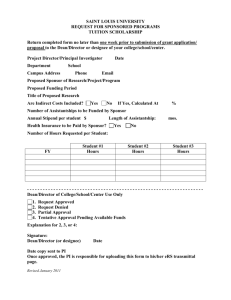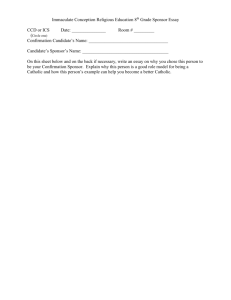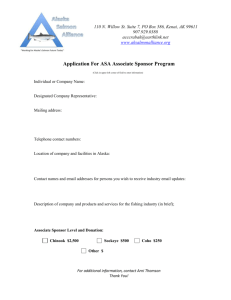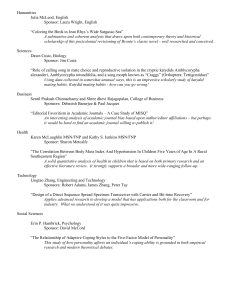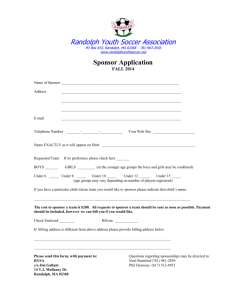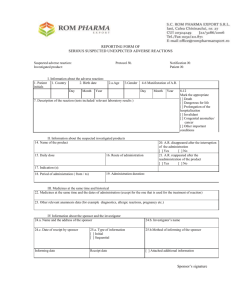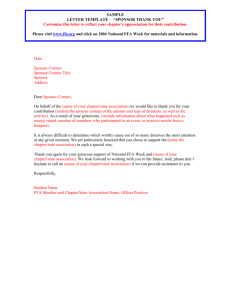- ProjectExperts
advertisement
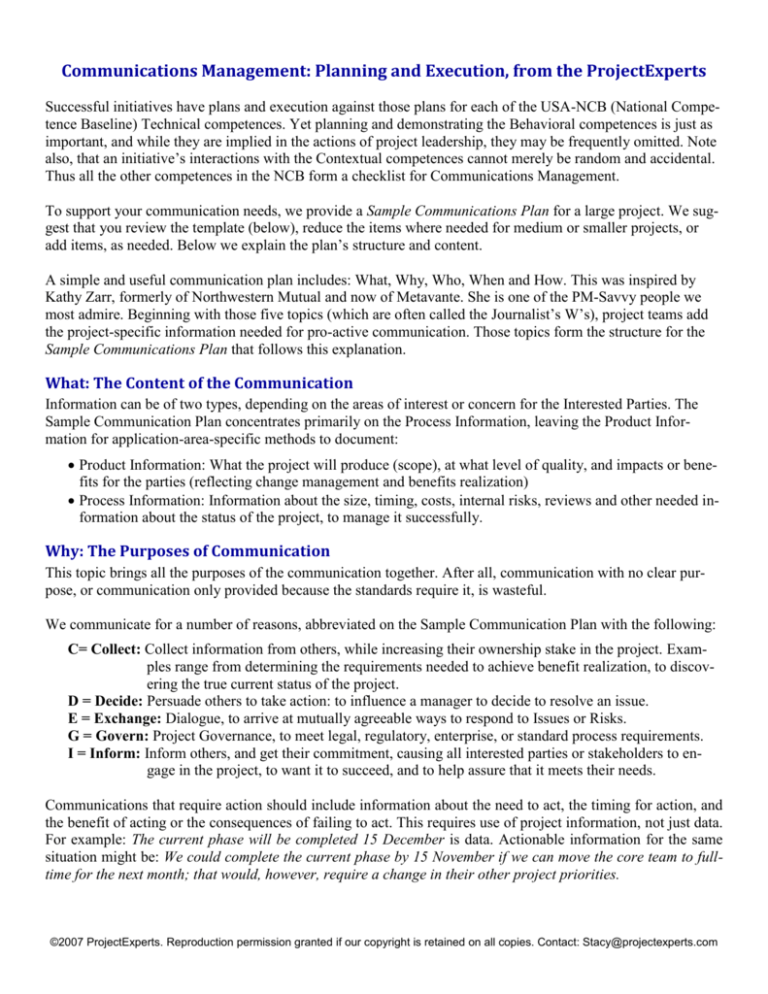
Communications Management: Planning and Execution, from the ProjectExperts Successful initiatives have plans and execution against those plans for each of the USA-NCB (National Competence Baseline) Technical competences. Yet planning and demonstrating the Behavioral competences is just as important, and while they are implied in the actions of project leadership, they may be frequently omitted. Note also, that an initiative’s interactions with the Contextual competences cannot merely be random and accidental. Thus all the other competences in the NCB form a checklist for Communications Management. To support your communication needs, we provide a Sample Communications Plan for a large project. We suggest that you review the template (below), reduce the items where needed for medium or smaller projects, or add items, as needed. Below we explain the plan’s structure and content. A simple and useful communication plan includes: What, Why, Who, When and How. This was inspired by Kathy Zarr, formerly of Northwestern Mutual and now of Metavante. She is one of the PM-Savvy people we most admire. Beginning with those five topics (which are often called the Journalist’s W’s), project teams add the project-specific information needed for pro-active communication. Those topics form the structure for the Sample Communications Plan that follows this explanation. What: The Content of the Communication Information can be of two types, depending on the areas of interest or concern for the Interested Parties. The Sample Communication Plan concentrates primarily on the Process Information, leaving the Product Information for application-area-specific methods to document: Product Information: What the project will produce (scope), at what level of quality, and impacts or benefits for the parties (reflecting change management and benefits realization) Process Information: Information about the size, timing, costs, internal risks, reviews and other needed information about the status of the project, to manage it successfully. Why: The Purposes of Communication This topic brings all the purposes of the communication together. After all, communication with no clear purpose, or communication only provided because the standards require it, is wasteful. We communicate for a number of reasons, abbreviated on the Sample Communication Plan with the following: C= Collect: Collect information from others, while increasing their ownership stake in the project. Examples range from determining the requirements needed to achieve benefit realization, to discovering the true current status of the project. D = Decide: Persuade others to take action: to influence a manager to decide to resolve an issue. E = Exchange: Dialogue, to arrive at mutually agreeable ways to respond to Issues or Risks. G = Govern: Project Governance, to meet legal, regulatory, enterprise, or standard process requirements. I = Inform: Inform others, and get their commitment, causing all interested parties or stakeholders to engage in the project, to want it to succeed, and to help assure that it meets their needs. Communications that require action should include information about the need to act, the timing for action, and the benefit of acting or the consequences of failing to act. This requires use of project information, not just data. For example: The current phase will be completed 15 December is data. Actionable information for the same situation might be: We could complete the current phase by 15 November if we can move the core team to fulltime for the next month; that would, however, require a change in their other project priorities. ©2007 ProjectExperts. Reproduction permission granted if our copyright is retained on all copies. Contact: Stacy@projectexperts.com Who: Recording Communication Responsibilities, and the Audiences Project communication is not just the responsibility of the Project Manager. After all, project Team Members are the source of the information to communicate, so clearly Team Members have communication responsibilities. Sponsors have a responsibility to keep the Enterprise appraised about the project, and to assure that all open issues are resolved in a timely manner. But communication will not occur if it is not clear who is responsible for it. When a Sponsor accepts the role of Sponsor of an Initiative, he or she requires some understanding of the responsibilities of the role, and the time it will require. Thus each entry in a Communications Plan needs to list not only which role(s) are responsible, but which persons will accept that responsibility. The audiences for communications can be narrow or very broad. Communication entries that list stakeholders as part of the audience may require more effort in communication than all the rest of the initiative. For example, a new product that requires training an entire International Sales Force may require more time to communicate with them, reduce resistance and fear, and manage expectations, than it takes to develop the new product. Stakeholders include all those persons or groups, internal or external to the permanent organizations, who are affected by a project’s results, or all who can affect its success. Late discovery of additional stakeholders is one cause of scope changes. It also increases resistance to the organizational changes needed to implement the project results successfully. Identify and communicate with all in the initiative’s audience, to maintain their interest and support of the project, and to manage expectations that their needs will be met. A range of early project activities should identify Interested Parties by role or name, establish communication with them, and help identify the unique information and methods of conveyance required by each. When: Timing or Periodicity of the Information In the Sample Communications Plan we have separated the different types of communication based on three different timings: Initial Communication, from inspiration until the team is formed and underway. This is key because often the majority of initiative problems occur because of gaps during this period. Recurring Communication, repeated throughout the initiative; a risk of this category is that it seldom shows up on schedules, may be demand-driven, and easy to skip for the novice. Close-out Communications, important both politically and in terms of benefit realization, the project is not over until the Sponsor and Interested Parties celebrate. Information provided too late is a waste: it is not actionable. There are two aspects to planning the timing of project information: One collects project data and information on an ongoing and as-needed basis. One reports the information either on a regular and predictable basis, or in cases where immediate action is required, on an as-needed basis. Less-competent Project Managers rely excessively upon “just too late” information collection. The Communications Plan should list the types of information to be communicated, and either their frequency, or the triggers that will cause it to be collected and reported. Action Preferences: Prevent, Intervene, Recover Different categories of certain project information have different timing in their occurrence. What are the differences and similarities between a Risk/Threat, an Issue, a Failure, and a Lesson Learned? ©2007 ProjectExperts. Reproduction permission granted if our copyright is retained on all copies. Contact: Stacy@projectexperts.com As presented at the Delhi, India IPMA World Congress (Goff, 2005), Risks, Issue, Failures, and Lesson Learned are all the same information, with different timings, as shown in the table below. They also have different urgencies for action. Information Type Timing Certainty of Impact Risk/Threat Issue Failure Lesson Learned Has not occurred, action could prevent Has occurred, opportunity exists to intervene Has occurred, recovery is only option May occur again in this project or later project Might impact Will impact Has impacted High chance of recurrence Triggering this analysis was the realization that it is often the same Lessons Learned that recurred in phase after phase, and project after project within some organizations. This led to an understanding that the lessons were not learned, but only recorded, perhaps because there was not enough compelling consequence of inaction information to lead to decisions. Some people prefer to recover from projects gone awry, rather than prevent the occurrence. For some this is just a preferred style. For others, they are overwhelmed with too many opportunities to prevent, and they rationalize that cannot prevent them all. Some enterprises perpetuate the problem: they provide no reward or recognition for preventing a disaster, but highly praise the heroes who come to the rescue in a failure—even though they are the ones who should have prevented it. For those who would otherwise act, many fail to receive the information they need to make a prioritization decision: what is the consequence of failure to prevent the problem? What is the likelihood of a failure? This is basic Risk Management information, but Managers do not always receive it. How: Communication Distribution and Reporting Given that some are readers and some are listeners, and others have preferences in the way they prefer to receive information. The effective project communicator seeking action must present the information in a way that is easiest for the respondent to act. This may mean considering providing summary information or details, providing visuals (charts and graphs) or data (words or numbers), and whether the delivery method should be formal or informal information (based on whether a trail is needed. Clearly, communicators do not have the flexibility to consistently produce custom information for each audience, but when you depend on the action of one or two decision-makers, you must target the communication preferences of the receiver. To compound this challenge, should it be online and interactive, or paper? Executing Communication Performing project communication is more than just executing a plan. It is an ongoing responsibility of each member of the project team to collect the information, to report it, and to respond, when needed. Whether the communication takes place in meetings, via email and reports, or face-to-face in one-on-one briefings, or just the ever-popular “managing by wandering around”, it can appear to be a burden. What is more burdensome is when Project Managers fail to assure that the communication is taking place, and the project suffers. Summarizing Communication Planning and Execution Develop a Project Communications Plan, using our template. Customize it to your needs. Then execute it. Remember that the best communication is usually face-to-face, and where required (whether because of regulatory requirements or because of faint trust) with a paper trail. And remember too: an ounce of prevention is usually worth a ton of cure—among competent communicators. ©2007 ProjectExperts. Reproduction permission granted if our copyright is retained on all copies. Contact: Stacy@projectexperts.com Sample ProjectExperts® Communication Plan Program or Project Communications can be one-time, periodic, or ad-hoc, as-needed. This is a template for a large project’s Communication Plan. Begin with this template, changing or deleting items as appropriate, and adding any other information needed to assure complete and effective project communication. What (The Content of the Communication) Why (Communication Purpose; then description. See purpose codes below) Who (Responsible, in italics, then Audiences) When (Timing or Periodicity) How (Typical Methods of Communication) A. Initial Communications I, E. Determine Business Case Initial Request Analysis Project Justification; Business Case or Need for the Initiative Portfolio Prioritization E, G. This is the foundation of approval and project continuation D, E. Evaluate Business Case, allocate Staff and other resources, and use funds wisely G. Approval to Proceed Initiative Authorization Kick-off or Start-up Meeting Sizing or Estimating, Evaluating Constraints and Assumptions Initiative Strategy or Approach Risk Assessment Point Initial or High-Level Plan Stakeholder Expectations Executive Presentations or Briefing Request for Proposal Bidders’ Meeting Proposal Contract Award I, E. Establish Charter, if used in the initiative. build a strong and committed team E, I. Understand the size of an initiative, identify initial effort and cost, and set timelines, typically for alternative strategies E ,I. Identify, evaluate and recommend alternative approaches, timings, staging, or delaying options, with strengths and weaknesses of the best alternatives E ,I. Identify and manage risk opportunities and threats, responses, and responsibilities for administering them I, D. Agree to high-level plan and commitments needed to achieve it; Approval to Proceed C, E, I. Get commitment to support changes resulting from effort I, E. Maintain executive awareness, thus retaining support I. Obtain offers to assist in the effort from viable sellers I, E. Answer all buyer questions so all have same information G. Submit an offer that wins the bid, meets buyer needs, and achieves seller purposes D, G. Recognize legal acceptance of buyer’s bid or proposal Requestor, Leadership Team; Decision-Makers Requestor, Sponsor; Executives, Decision-Makers At Concept; then updated as it changes As early as possible, updated with changed and/or approved status Documented Discussion, Analysis, Formal Report Discussion; Analysis, Informal or Formal Report Executives, Decision-Makers; Sponsor, Leadership Team, Interested Parties Executives, Decision-Makers; Sponsor, Leadership Team Sponsor; Leadership Team. Team Members Leadership Team; Sponsor, Decision-Makers At Portfolio Analysis; may be recurring, given new, higher priorities Meeting, Discussion, Analysis of Justification At Approval, or if approval is later rescinded Day one of initiative, or of each sub-component As early as possible, updated with changed and/or approved status Meeting: Discussion, Decision Leadership Team, Sponsor, Team Members; Decision-Makers, Interested Parties As early as possible, updated at major review points, or upon changes in plan Leadership Team, Sponsor, Decision-Makers, Team Members; Executives, Interested Parties Sponsor, Leadership Team, Decision-Makers; Executives, Interested Parties Sponsor, Leadership Team; Interested Parties Sponsor; Executives, Interested Parties Buyer; Seller As early as possible, updated at major review or risk realization points As early as possible, updated with changed and/or approved status Meeting; Structured Discussion, Informal Report As early as possible, updated with changed and/or approved status Very early, and then ongoing as needed When a Buyer/Seller contract approach is an appropriate strategy When a Buyer/Seller contract approach is an appropriate strategy When a Buyer/Seller contract approach is an appropriate strategy Meetings, phone calls or Interviews; summary report Presentation, Videocast or Briefing Targeted Solicitation Letter to qualified Sellers Meeting with Discussion, Minutes Formal Report, often with presentation When a Buyer/Seller contract approach is an appropriate strategy Meeting with audit trail in a Formal Report Buyer; Seller Seller, Buyer, Decision-Makers [, Executives] Buyer, Decision-Makers; Seller, Sponsor, Interested Parties, [, Executives] Meeting; Discussion, teambuilding exercises Meeting; Discussion, multiple forecasting methods; documented traceable results Meeting; Structured Discussion, Informal Report Meeting; Structured Discussion, Formal Report ©2007 ProjectExperts. Reproduction permission granted if our copyright is retained on all copies. Contact: Stacy@projectexperts.com What (The Content of the Communication) Why (Communication Purpose; then description. See purpose codes below) Who (Responsible, in italics, then Audiences) When (Timing or Periodicity) How (Typical Methods of Communication) B. Recurring Communications A Phase Plan E, I. Identify timings, resources needed for next phase(s) Work Package Assignment Individual Time Reporting Individual Status Reporting I, E. Delegate and understand assignments well enough to estimate them accurately E, G. Accurately report effort expended and cost consumed, with estimates to complete I, E. Each team member summarizes status on all open and pending assignments Managing By Wandering Around Project Team Diary C, E. Pro-actively collect current information from team, without micro-managing E. A safe way, either anonymous or signed, for team members to share perspectives, attitudes, concerns, questions and accomplishments C, E. Helps to correlate multiple data or information points, and drill down to details, where needed, to see true status I. Raise Issues that affect project success. analyze their impact. track open issues D. Resolve open Issues before they impact the initiative Team Status Meetings Leadership Team, Team Members; Sponsor, Decision-Makers, Interested Parties Leadership Team, Team Members; Interested Parties [, Seller] Team Members; Leadership Team Team Members; Leadership Team, Interested Parties At phase start, updated with approved changes Meeting or collaboration with informal report Phase start or within phase for work package details Daily for assignment effort and as needed for changes in assumptions Periodic, weekly or bi-weekly for current assignments, or as identified in plan Leadership Team; Team Members, Interested Parties Team Members, Leadership Team; Interested Parties On an ongoing basis; problems occur when you are not watching On an ongoing basis, and as needed. Especially important to observe activity level and content when team is in “crunch mode” On a regular basis, depending on project urgency; weekly or biweekly When Issues Occur Meeting or collaboration with informal report Time sheets with retention rules; automated entry Informal report for all current efforts; ideally, use of tagged XML routes each item to the appropriate project manager Random or targeted discussion Wikis are perfect for this, because they can be posted by individual or anonymously Leadership Team; Team Members, Interested Parties When Issues Occur, and before they impact the project Meeting with discussion, informal minutes; summarized in Project Log Formal report and log of open issues and their latest status Formal report and impact of issues resolved too late When Changes Needed Discussion, analysis of impact Formal report and recommendation; project impact and resolution Formal report or electronic report, with briefing for decisionmakers who are listeners Discussion, analysis, action, informal or formal report Electronic or paper newsletters, reports, or video/podcasts Change Order or Change Request Change Authorization E, I. A request or required change Team Members; Sponsor, Decision-Makers, Interested Parties Sponsor, Leadership Team; Decision-Makers, Interested Parties [, Executives] Requestor; Leadership Team D, G. Approve and fund a needed change, accepting impact on initiative time and cost Sponsor, Decision-Makers; Leadership Team [, Executives] Periodically review and resolve evaluated changes Status Report, with performance analysis, updated forecasts Risk Realization Point or Risk Trigger occurs Targeted Stakeholder Presentations or Newsletters Funding Requirements Status Update StopLight, Thermometer, Countdown or Burndown Charts Press Releases, Newspaper Interviews or Articles G. Identify current status and planned end date and cost; includes open issues, accomplishments, and a high level schedule D. Implement or identify Risk Responses to mitigate impact or recover I. Inform about progress and organizational change impacts Leadership Team; Team Members, Sponsor, Decision-Makers [, Seller] Leadership Team; Sponsor, Decision-Makers, PMO [, Sellers] Leadership Team, Sponsor; Interested Parties Weekly or in a cycle identified in the plan I. Improve Treasury cashflow management efficiency and assure ongoing funding I. Visually show progress in results, and/or time or cost used, to maintain excitement with those who prefer charts to numbers I. For projects with public interested parties, to maintain popular support and interest Leadership Team, Sponsor; Decision-Makers [, Executives] Leadership Team; Sponsor, Interested Parties [, Executives] Monthly, or as identified in Communication Plan Monthly, or as identified in Communication Plan Sponsor, Decision-Makers; Interested Parties, Team Members If needed, every 4-6 weeks (or the limits of public attention span) Issue Reporting and Logging Issue Resolution As Risks are Realized Monthly, or as identified in Communication Plan Formal report or email with a trail Graphic representation on Project Room walls, in presentations or electronic reports Electronic or paper updates sent to appropriate media ©2007 ProjectExperts. Reproduction permission granted if our copyright is retained on all copies. Contact: Stacy@projectexperts.com What (The Content of the Communication) Why (Communication Purpose; then description. See purpose codes below) Who (Responsible, in italics, then Audiences) When (Timing or Periodicity) How (Typical Methods of Communication) Experts, Leadership Team; Interested Parties, Team Members [, Decision-Makers] Leadership Team; Team Members [, Seller] PMO, Auditors; Leadership Team, Sponsor, Decision-Makers [, Executives] Sponsor, Decision-Makers; Leadership Team, Team Members At completion of Work Packages or key results within a phase Formal report with approval or, open items and tracked closure Discussion and informal documentation of results Discussion, evaluation of documentation, analysis; informal or Formal report, as needed Meeting with decision and a Formal report to document the outcome Electronic or paper publication of project accomplishments Solicitation, then discussion, of Lessons Learned; analysis and then informal reporting Best left undocumented, except to identify who approved it Legally-binding Formal report, subject to retention periods Meeting with discussion and agreement that the effort has or has not delivered to needs; Formal report produced Meet to evaluate process and results, identifying any adjustments needed to achieve benefits; Formal report produced Formal report evaluating the extent to which promised benefits met or exceeded None, except for financial impact for future project budgets C. Close-out Communications (assignment, phase or project) Quality Assurance Review or Acceptance Review Work Package Closeout Progress and Process Audit Milestone or StageGate Review I, D, G. Verify completeness, acceptability and correctness of incremental results E. Accept incremental results and discuss process improvements E, G. Assure that appropriate processes are being applied, and progress reporting is useful, accurate, and is being used D, G. Approve results to date, and approval to proceed, revise or cancel I. Promote the initiative, recognize accomplishments C, E. Capture and apply the most important Lessons Learned for later in this initiative, and for later initiatives I. Reward all stakeholders for phase and initiative results E, G. Formally accept seller results and authorize payments E, D, G. Formally end the initiative and accept its product(s) Leadership Team; Executives, Interested Parties, Team Members Leadership Team, Team Members; Sponsor, Decision-Makers, Interested Parties Sponsor; Team Members, Leadership Team, Interested Parties Buyer, Decision-Makers; Seller, Interested Parties Sponsor, Decision-Makers; Leadership Team, Team Members, Interested Parties Post-Project Evaluation E, D, G. Evaluate process and products, assuring intended benefits are being captured; adjust if not Decision-Makers, Sponsor; Executives, Leadership Team, Interested Parties Benefit Realization C, E, G. Evaluate results to assure promised benefits realized Bonuses & Rewards; e.g.: a 3-week vacation to Exotic Places D. Reward all who contributed to success, to encourage future successes Sponsor, Executives; Interested Parties, Leadership Team, Team Members Decision-Makers, Sponsor; Executives, Leadership Team, Team Members, Interested Parties Progress Report Lessons Learned Team Celebration Contract Closeout Project Closure At completion of Work Packages or assignments Before major Milestones or StageGate reviews, or at most each 6-12 weeks, depending on initiative size At Major Milestones or Stage-Gate approvals; no more than 2-3 months apart in most projects Every 4-6 weeks End of each phase, stage, and subset; summary at end of initiative End of each phase, stage, and subset; major celebration at final end End of each contract End of each project in an initiative; end of program for those that do end (some have an ongoing portion) Within a predefined period after initiative end, usually at least one business cycle, and often at least 25% of the initiative’s duration after Predefined period after initiative end, usually at least one business cycle When promised initiative benefits have been realized Based on Goff, The Project Guide; 1990 Comments? Questions? Contact Stacy Goff, www.ProjectExperts.com ©2007 ProjectExperts. Reproduction permission granted if our copyright is retained on all copies. Contact: Stacy@projectexperts.com Key to the abbreviations in the above table Why: Communication Purpose codes Who: Responsible, in italics, and Audiences When: Timing or Periodicity C Collect Information from others, while increasing their ownership stake in the project The Who’s in italics are Responsible. The others are the target audiences. The majority of the items are recurring, with as-needed updates after initial establishment D Decide: Action Required; persuade others to take action: to influence a manager to decide to resolve an issue E Exchange Information: Dialogue, to arrive at mutually agreeable ways to respond to Issues or Risks G Govern: Project Governance, to meet legal, regulatory, enterprise policy or standard process requirements I Inform others, and get their commitment, causing all interested parties or stakeholders to engage in the project, to want it to succeed, and to help assure that it meets their needs Additional Notes: Sponsor could be multiple persons, from multiple enterprises; or they could be a Steering Committee How: Methods of Communication The methods depend on whether a topic is formal or informal, and within or beyond the team. Communications may have retention requirements. Auditors could be Internal or External Formal Reports and Proceedings can use paper, or be electronic with access and tracking controls. They usually must leave an audit trail. Key Decision Makers include managers of internal team members within or beyond the Sponsor’s control, or mangers in the Seller organization Informal Reports can be paper or electronic; if electronic, project wikis or collaborative software can be useful. Executives include Management in the top several levels of the enterprise Interested Parties include Stakeholders and internal Customers Leadership Team includes Program and/or Project Managers, Team Leads, and captive PMO’s PMO is an independent Project or Program Management Office Sellers also include any Subcontractors Meetings can be virtual or onsite; depending on their purpose, their results are either Formal or Informal. Discussions and Phone Calls rarely leave a documentation trail unless they are part of a formal event. Emails leave a trail and have retention requirements, while text messaging typically does not (currently). Experts are Subject Area Experts Additional Comments This chart reflects one area of communication: that needed for the Project Processes. The communication plan for Project Products is separate, and highly dependent on the subject area of the project. Even the way the Product information is stored may vary by the application area, as some (or many) emerging services provide full-life-cycle configuration management of this information. The usefulness of this Sample Communications Plan also depends on the PM Competence of the Enterprise or organization using it. For example, in some organizations Sponsors and key Decision Makers may not be prepared to accept responsibility for success to the extent we expect them to. In that case, those responsibilities drift downward, to exceptional managers and key individuals in the Leadership Team. Similarly, in some organizations, Team Members feel that managing their own part of the initiative is not their responsibility, but that of the Project Manager or Team Leads. This particular challenge to effective communication requires time and patience to overcome, but is possible in most Enterprises. Some of the items are only important in certain circumstances. For example, the Buyer/Seller items are only applicable if the initiative involves contracts. If that is the case, there could be multiple instances of these items. Similarly, if the funds are not significant (and this is very relative, depending on the Enterprise) there may be little need to provide a Funding Requirements Status Update. Finally, there may be many more Enterprise-unique items that you should add to this sample. ©2007 ProjectExperts. Reproduction permission granted if our copyright is retained on all copies. Contact: Stacy@projectexperts.com
